Germany
Stotz
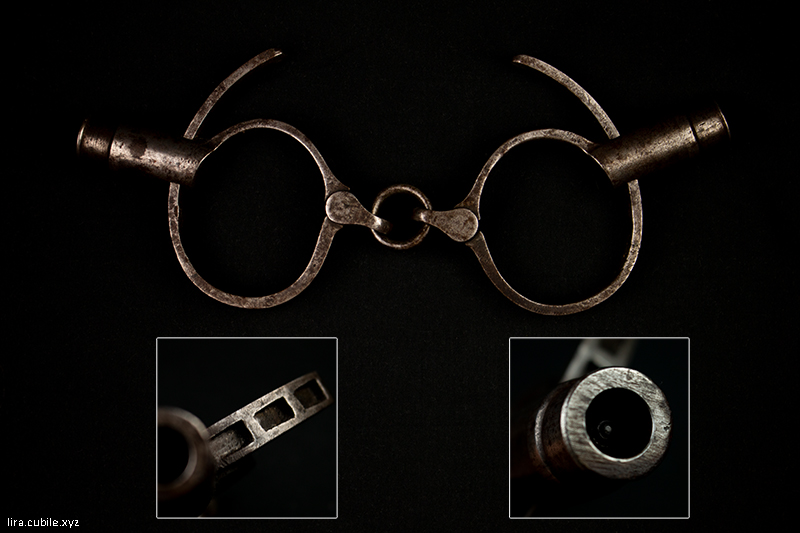
Other than darby handcuffs, Stotz have their lock outside the bow, but the same function.
So the key is also a darby typical screw key.
On real stotz handcuffs, the hole where the lock will snaps in are rectangular.
They don't have a doublelock.
This model was produced between the late 1890s until sometime between the two world wars.
Otto Schlüter
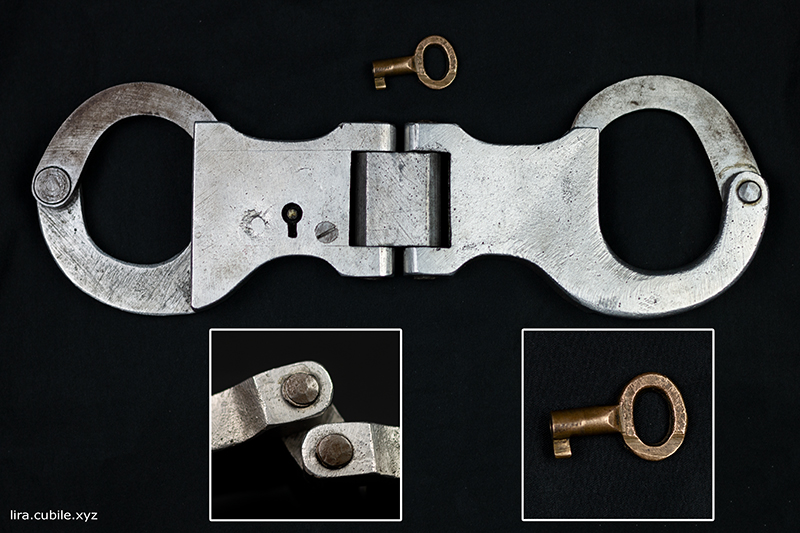
A very rare handcuff from the early 20th century. People thought it's a model of "Otto Schlüter" because he has a model which looks a bit like this handcuff.
Other people thought it also could be one of the first models of "August Schwarz".
Striking is on the one hand the hinge which is connected to the cuffs by two rough-hew rivets and on the other hand the bow, which is, typical for "Deutsche Polizei" handcuffs, only connected on one side to the cuff.
August Schwarz
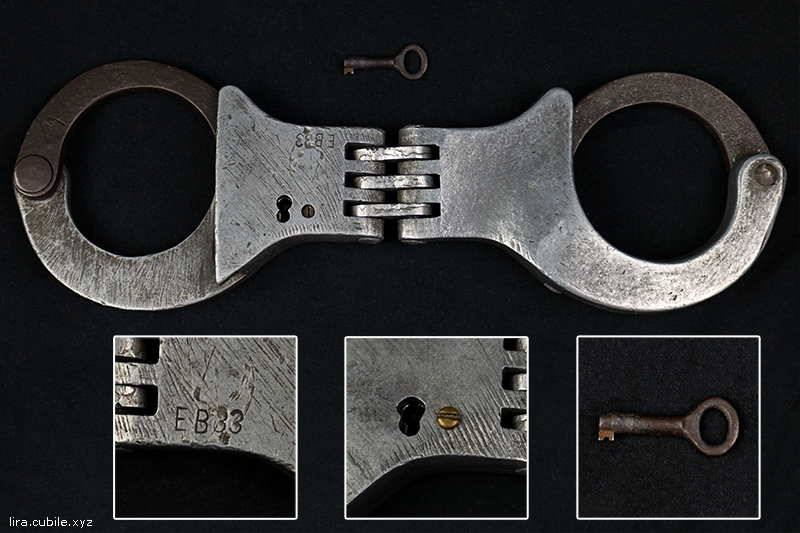
That's the third model August Schwarz produced and started the "Deutsche Polizei" series, which still exists today.
Also, it's the first model which has the typical bow, which is only connected to one side of the cuff.
You can change the lock if the cuff is open with the little screw.
The screw you see here on the left side looks a bit different than the ones you see normally (like the one on the right side).
I don't know if this is original, too.
The doublelock can be enabled with the key.
On one side there stands "EB 33".
Maybe thats the year when it was produced (1933)?
Schutzmarke Deutsche Polizei, Hagge
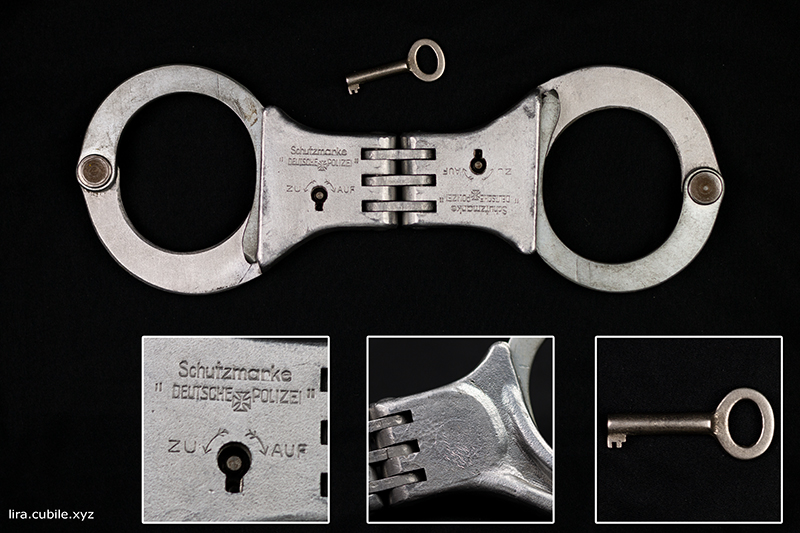
This is an older version of the "Deutsche Polizei" handcuff Germany uses until today.
This version's doublelock can be enabled with the key, other than the modern versions who has two levers (one for each cuffside) on the back.
Other than earlier versions of Reher, this Hagge version already has elevations on the backside. Because of this fact, it's clear that this is a Hagge model.
Hagge bought the "Deutsche Polizei" in the 1977, so this cuff must be younger than 1977.
Schutzmarke Deutsche Polizei, Heinrich Hagge
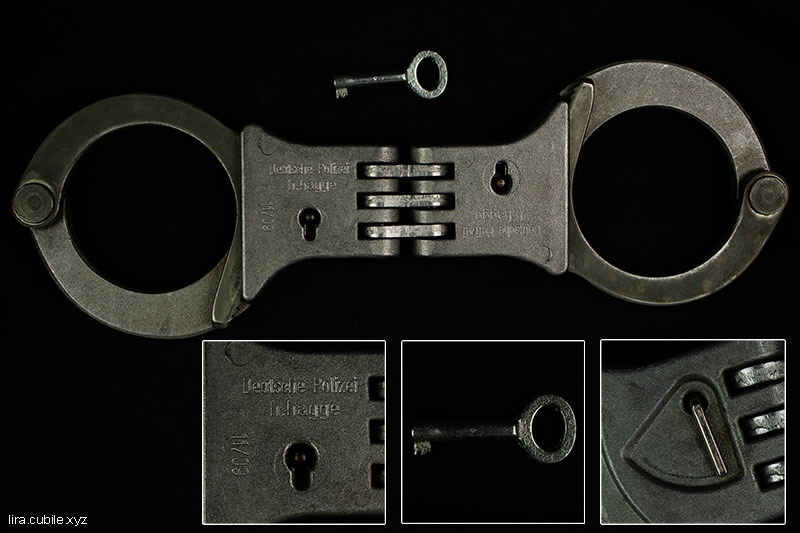
This is an actual one of the "Deutsche Polizei" handcuff Germany uses until today. Because it has "h.hagge" stamped into it, it should have been produced around 2004.
This version's doublelock can be enabled with the key like the older ones, too, but the speciality are the two levers (one for each cuffside) on the back, which enable the doublelock.
Horst Stein moabit 615
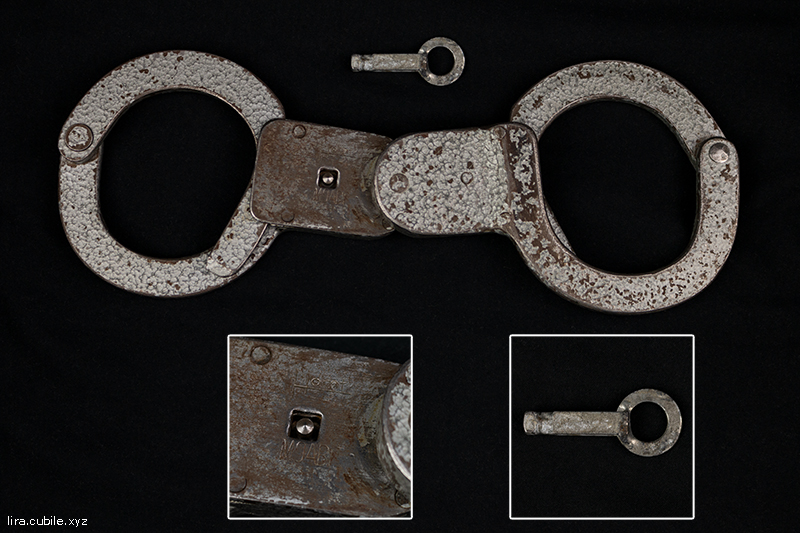
This handcuff is one of the German handcuffs which are a must have for every handcuff collector.
My version is a full metal version with hammer finish.
Special on this cuff is the unusual hinge, as well as the key and the lock.
The key is a square-headed key and the lock doesn't have normal teeth, it has holes in the swing and a kind of round thorn which holds the swing.
The cuff was made in the mid 20th century in Munich.
It has a doublelock, if you turn the key 45° counter-clockwise.
DDR 1
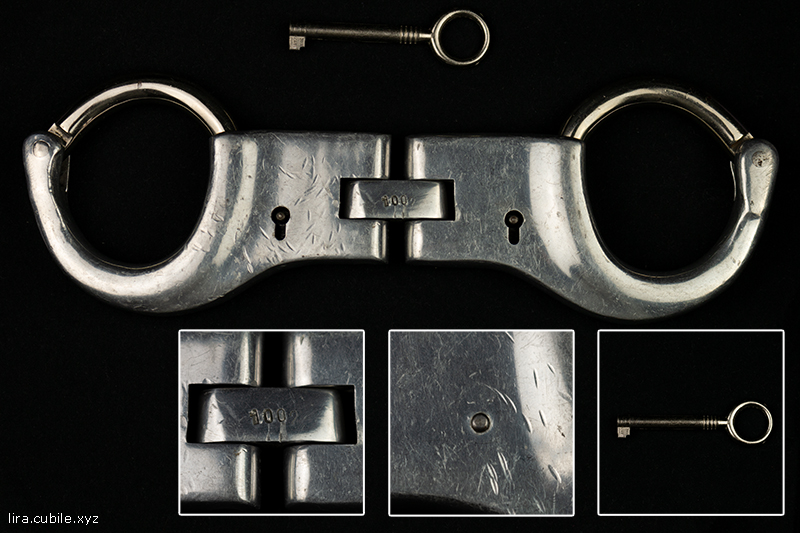
This is the first form of the handcuffs which were produced in the GDR. Other than the models after this one, it has no swing-through bows!
The doublelock is a bit tricky in my opinion, because you must turn the key by 45° to lock it... If you turn too far, the cuff will open.
The key is selfmade, because the key I got with this cuffs didn't fit. It was smaller and could to open the cuff, but couldn't reach the doublelock.
DDR 2
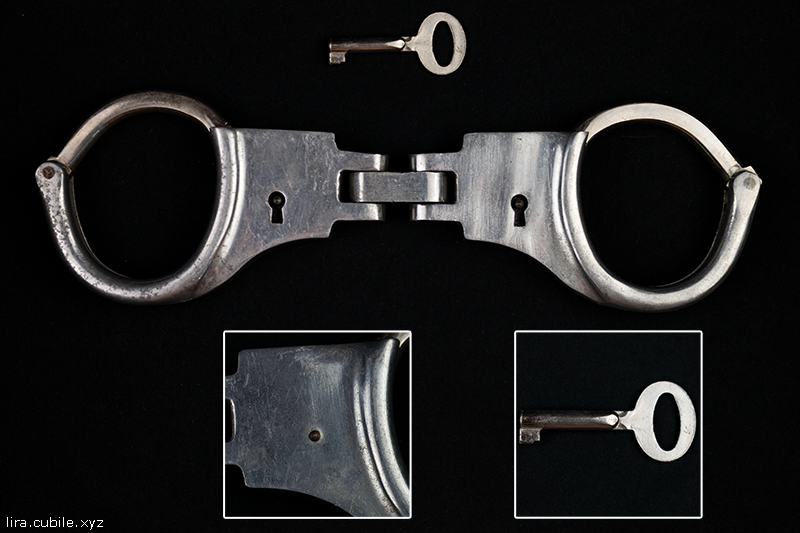
It's the second version of the handcuffs which were produced in the GDR. Also it's the first GDR model where the bows are able to swing through.
The doublelock is a bit tricky in my opinion, because you must turn the key by 45° to lock it... If you turn too far, the cuff will open.
The key is selfmade, because the key I got with this cuffs didn't fit. That's because the DDR 2 key is, other to the DDR 3 key, a bit smaller and shorter.
DDR 3
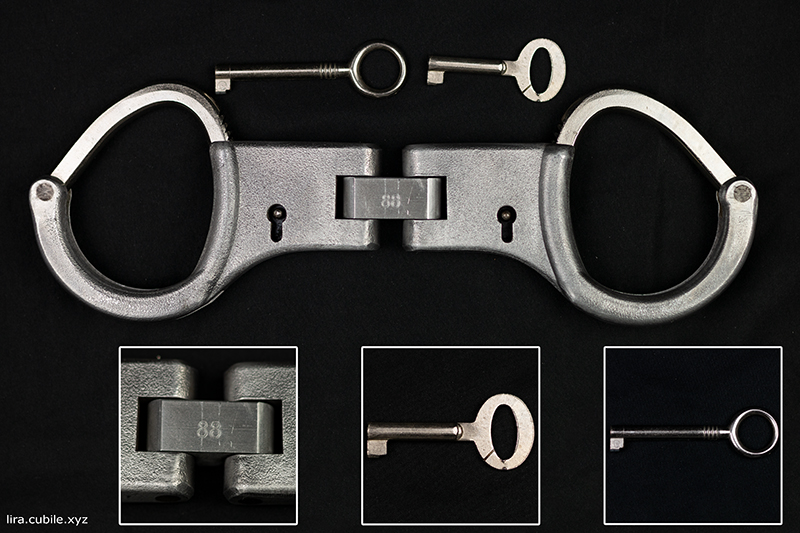
The third version of the handcuffs which were produced in the GDR. This one is also the last one produced.
The doublelock is a bit tricky in my opinion, because you must turn the key by 45° to lock it... If you turn too far, the cuff will open.
Except for the bows (which are nickel-containing steel), the whole cuff is made out of aluminium.
It's not totally clear what's the original key to this cuff.
Most people I know think the shorter one is the real one and the "locker key" (the longer one) is made for lockers, but because of the planned economy they were used for this handcuffs.
DDR leg cuff
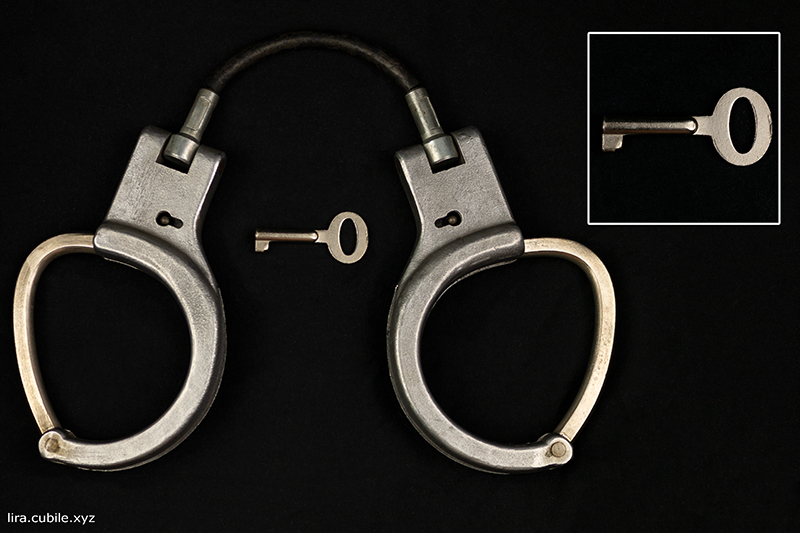
The leg cuff of the GDR. It looks like the DDR 3 in a bigger version and the function of the cuff is the same.
To activate the doublelock, you must turn the key by 45°. If you turn too far, the cuff will open.
Except for the bows (which are nickel-containing steel) and the rope, the whole cuff is made out of aluminium.
The rope, which is flexible, so it's no problem while wearing it, is made out of a rubber covered steel rope.
DDR chain nipper

An chain nipper which was used in the GDR. It's made out of aluminum and is super light.
You can easily break somebody's wrist with this chain...
A.W. Naht
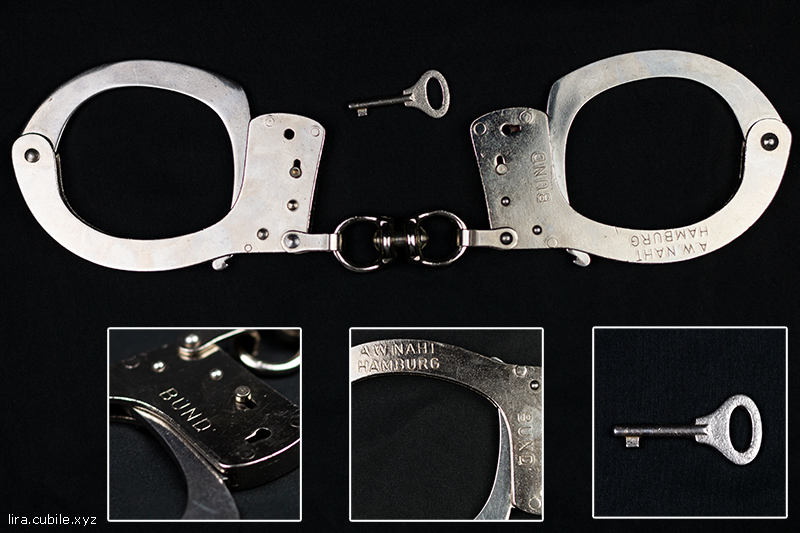
Old handcuffs from the "Bundeswehr". This type was only produced for the German Army.
The doublelock is a small lever on the cuff. To open the cuff, you must turn the key the other way around as you would to open it to unlock the doublelock, before you are able to open it.
Attention: The key looks almost as the key of the Clejuso 12D. But if you use it, it can get stuck!
Clejuso 12 D
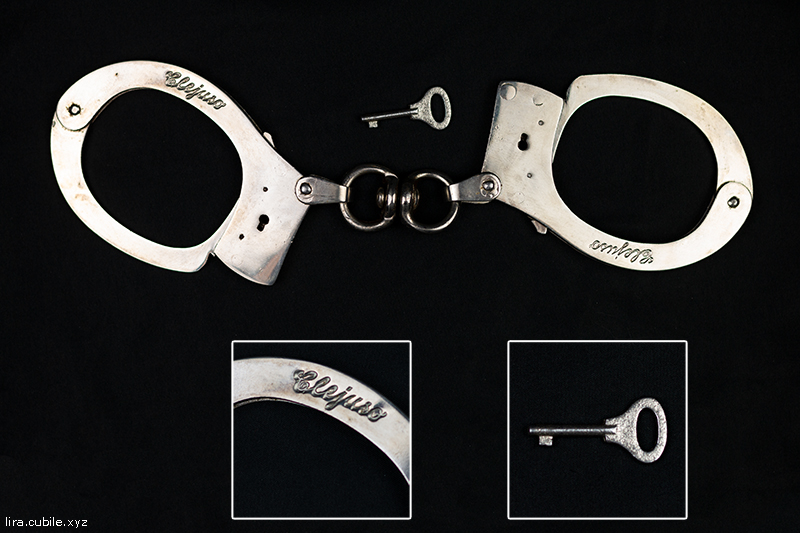
Old police handcuff which nearly looks like the A.W. Naht.
This version has a doublelock with the key. It also exists versions of the 12D without doublelock.
Attention: The key looks almost as the key of the A.W. Naht. But if you use it, it can get stuck!
Clejuso 12 D with separating plate
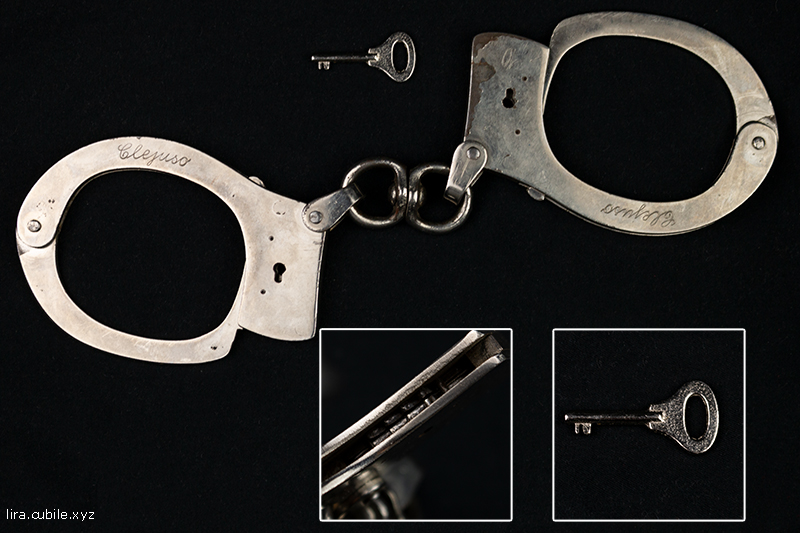
Nearly the same handcuff like the Clejuso 12D. Special to this version is the separating plate in their lock which prevents shimming.
The key is selfmade, because my friend didn't has a key for the separating plate version anymore.
Clejuso 12 D with separating plate and middle connection
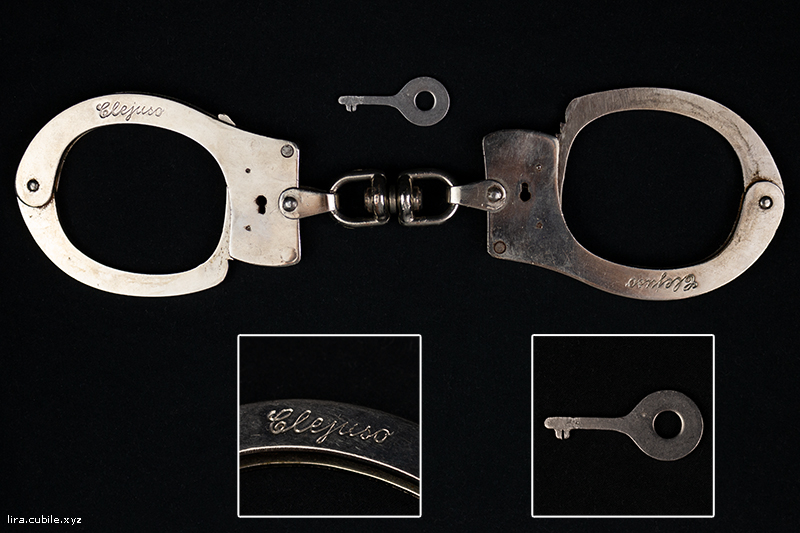
The same handcuff like the Clejuso 12D with separating plate. Only the middle connection is different and for this handcuff I have the original key.
The middle connection was produced for the Frankfurt police. So this version of the Clejuso 12D is also called "Frankfurter".
Clejuso 12 D heavyweight
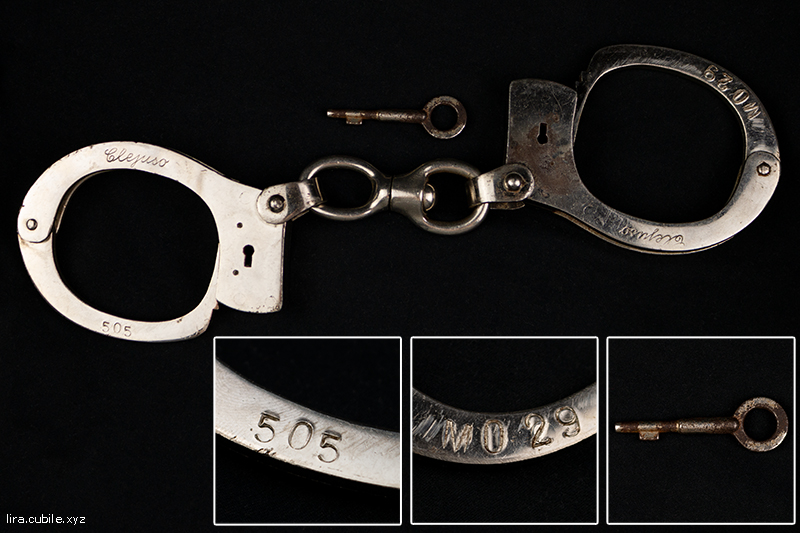
This handcuff is made out of two "normal" Clejuso 12D handcuffs. So it has double the weight of a normal one.
The swivel is also bigger than of a normal version.
Apart from these differences, this handcuff works like the normal version.
Clejuso 12 R
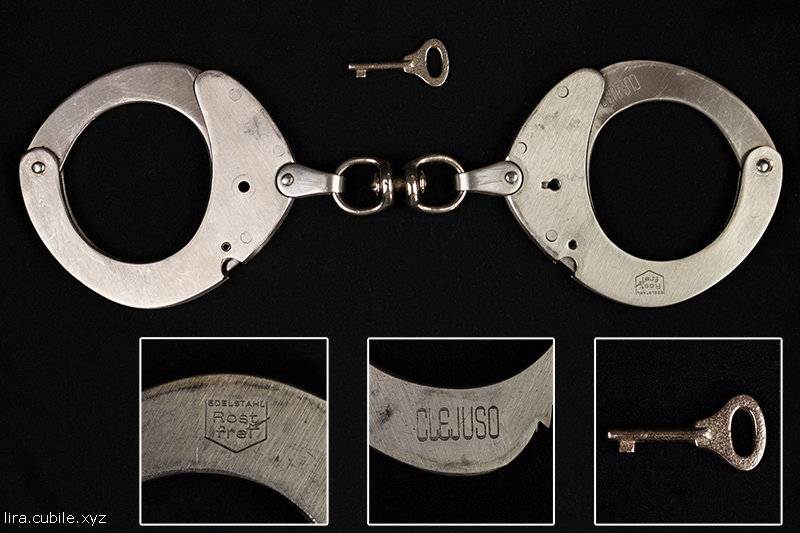
Thats the version between the 12 D and the 12 RK. Still with the swivel which was typical on the 12 D, but with a newer form.
It's also the first version with the push pin doublelock you can push with your finger. So you don't need the key near the cuff when locking it.
Clejuso 12 RK
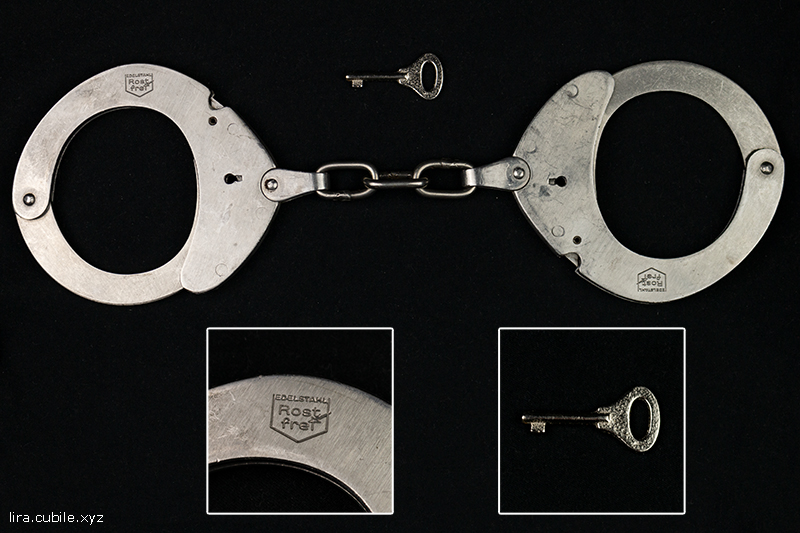
A newer Clejuso model than the 12 D, but still an old handcuff type. This version also already has the normal chain of the modern Clejuso 11/12.
Here you can already see the typical Clejuso form and the push pin doublelock. So you don't need the key near the cuff when locking it.
Clejuso 11
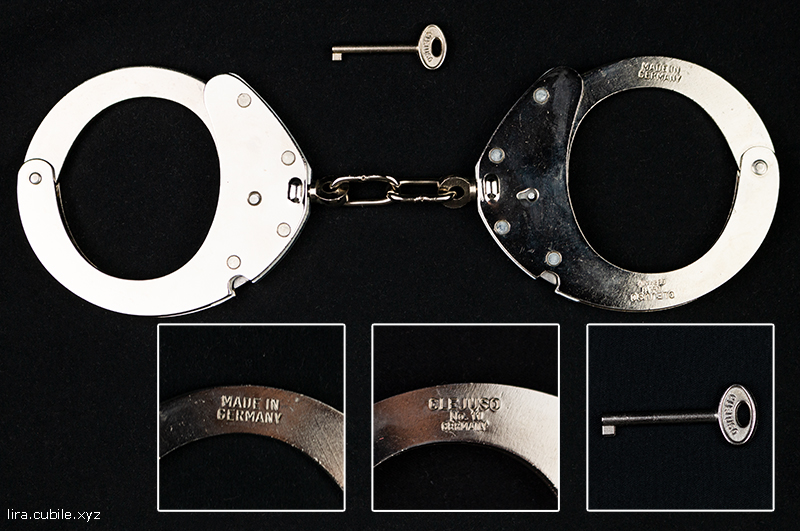
The modern standard handcuff from Clejuso. It's made out of nickel.
The doublelock is on the side of the cuff and can be pushed with the finger. So you don't need the key near the cuff when locking it.
Clejuso 12 A
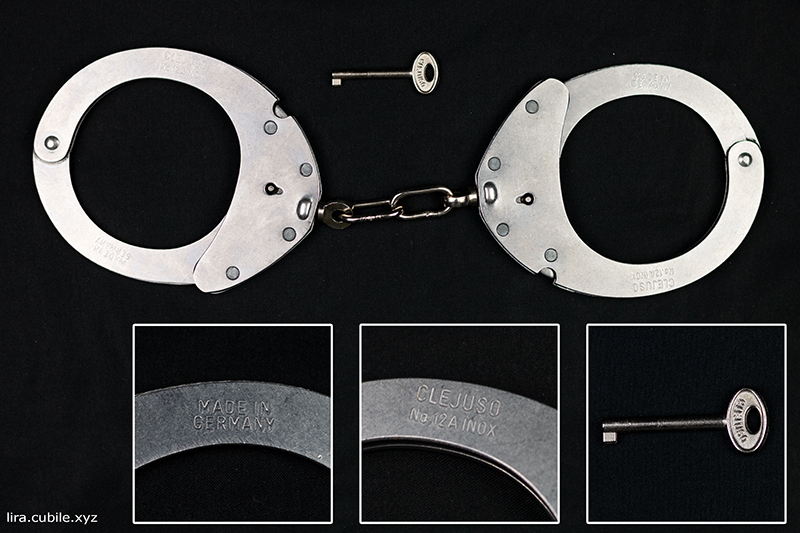
A modern handcuff. This one is the steel version of the standard model from Clejuso in the bigger form.
The doublelock is on the side of the cuff and can be pushed with the finger. So you don't need the key near the cuff when locking it.
Clejuso 13
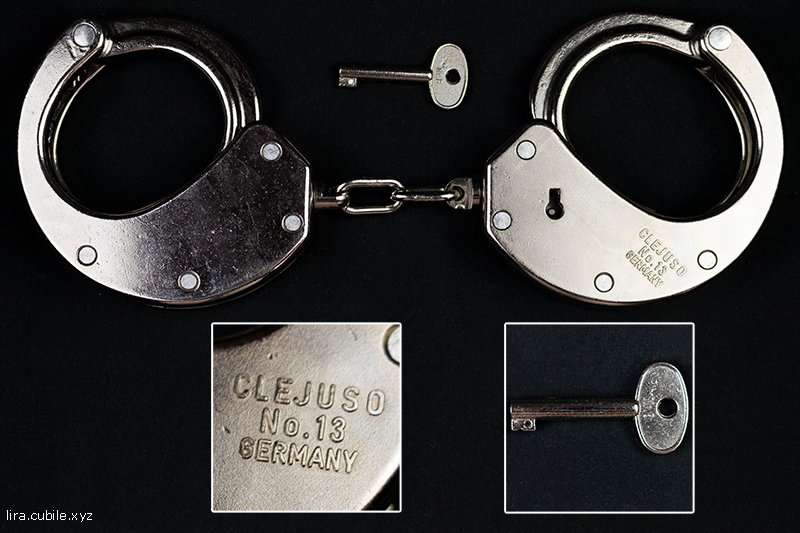
This one is a heavier cuff, which I also saw being used in the justiciary of Germany a few times if you take a look at pictures of trials.
It weighs nearly 1kg and also has a finger pushing doublelock.
Special on this cuff is the key, because "No.8" is embossed on them, other than the newer keys, which have "No. 13/15" on them.
So I can say for sure, that my version must be an older one, because the earlier versions all have the "No. 8" key.
Clejuso 15 with 5cm bar
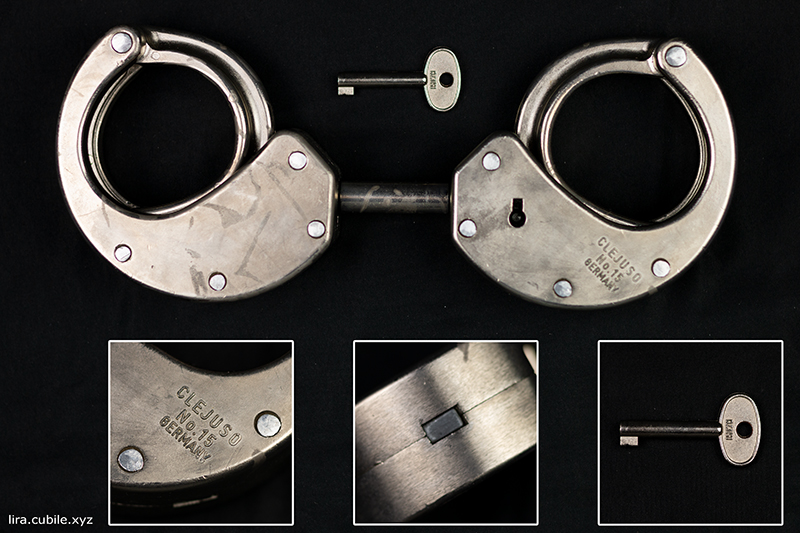
A special version of the heaviest cuff from Clejuso. Normally, this cuff has a regular chain. The bar is a special form.
This cuff weighs 1.3kg and also has a finger pushing doublelock.
Clejuso 19R
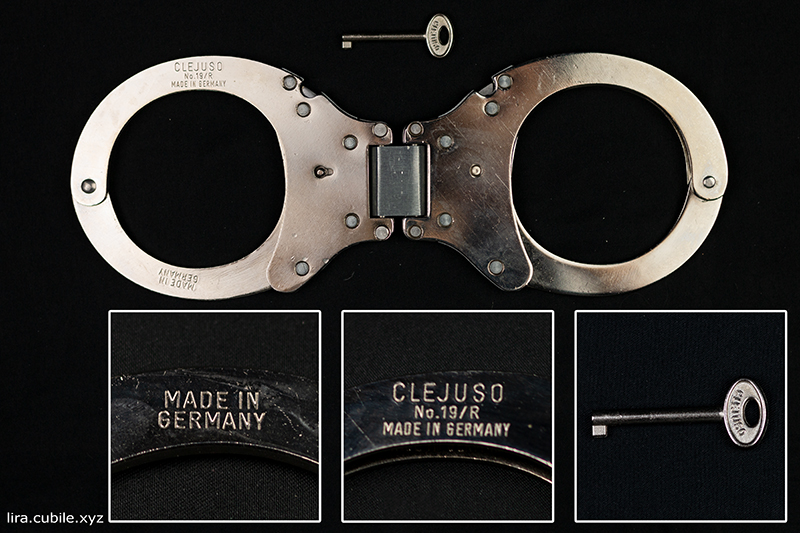
The hinged version of a Clejuso 11. This one is a nickel version.
The doublelock is on the side of the cuff and can be pushed with the finger. So you don't need the key near the cuff when locking it.
Clejuso 8
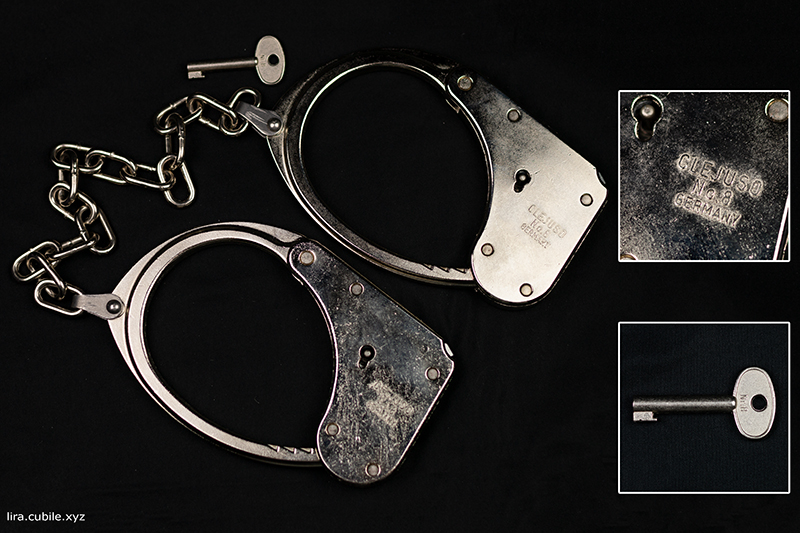
The leg cuff from Clejuso. Because of the form you need the key to open it.
It isn't swing-through.
Also this version has a finger push doublelock.
Clejuso 109 (cut)
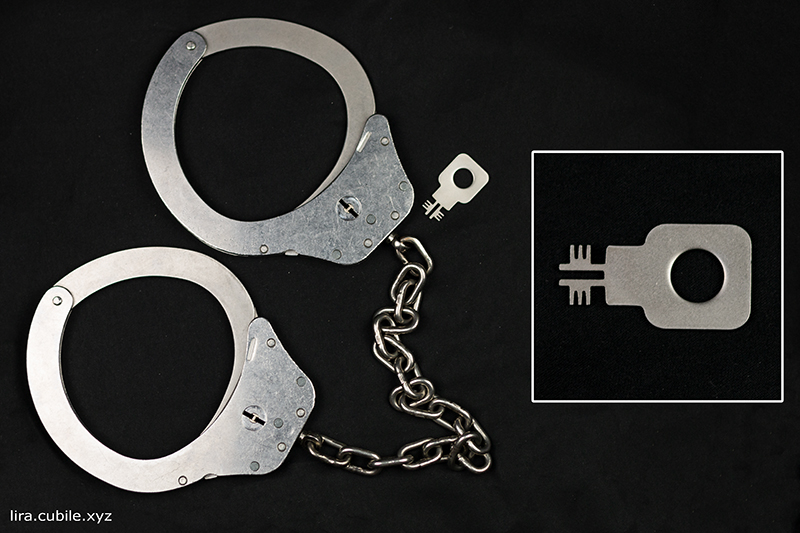
This version is a leg cuff, only authorities can get. So citizens are not able to buy it, because of the special key form.
The key can be inserted from both sides of the cuff.
The doublelock is also a finger push.
My version is cut into two pieces.
The cuff includes the German TRI (in english: technical guideline).
Clejuso 1

This chain nipper is also a modern one, but not used anymore.
You can easily break somebody's wrist with this chain...
Clejuso 6
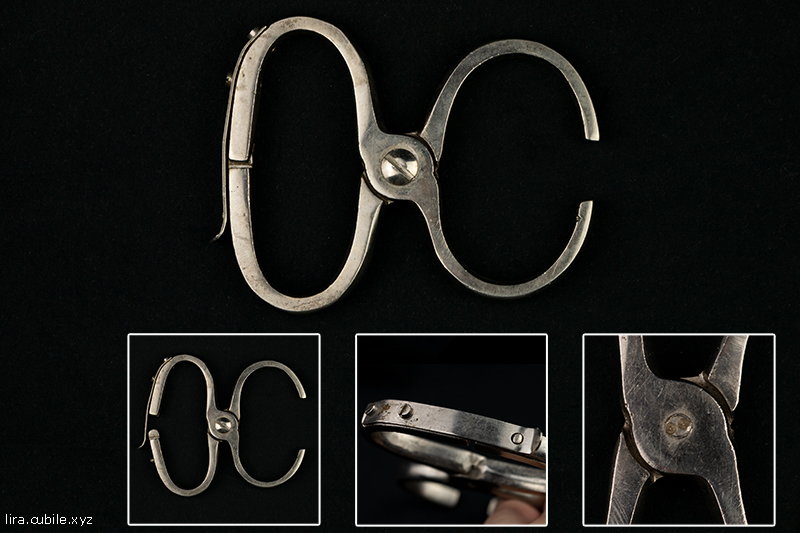
An old nipper from Clejuso. Clejuso is still producing it for historical reasons, but nobody uses it anymore.
You need to open the lever on the backside of the nipper to open it and just need to push it together for closing it.
Unknown german nipper
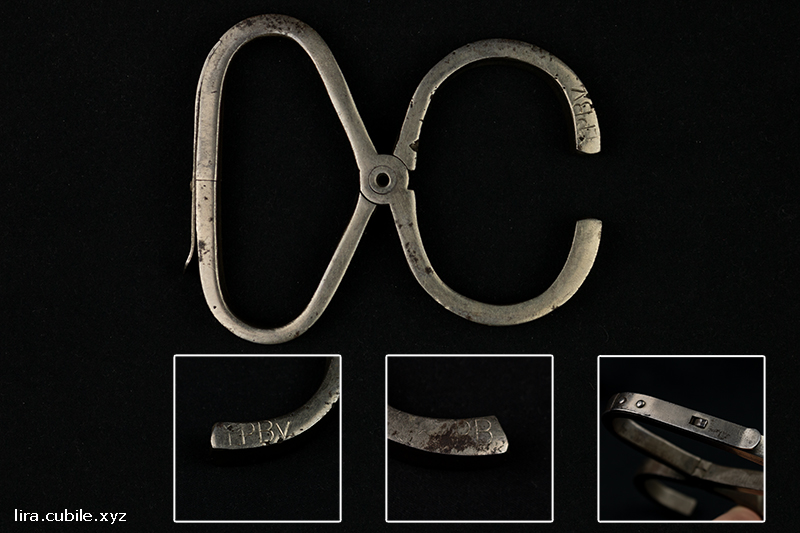
An unknown nipper which was used in Germany. The handle is more like a triangle than the oval form of Clejuso nippers.
It's also a bit bigger than the Clejuso one.
The only marking you find on this nipper is "LPBV" on the frontside.
You need to open the lever on the backside of the nipper to open it and just need to push it together for closing it.
Heinkel nipper
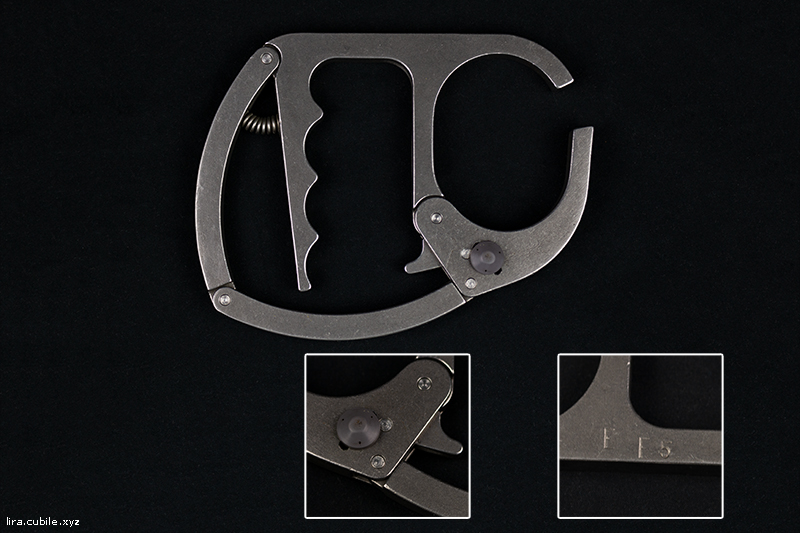
The Heinkel nipper was used in Germany. It's a special nipper, because of the kind of the mechanism.
Other than the two nippers above, this one has a spring with which you trigger the mechanism.
To close it, just press the handle.
To open, push the small lever on the bottom of the nipper.
This lever can also be adjusted, how wide it will open.
Heid and Roth nipper

This german nipper is spring-loaded.
To open it, you must push the two sides together and the backside will fold up to the back.
If you stop pushing, the nipper will jump to the closed position.
Bonowi Trilock
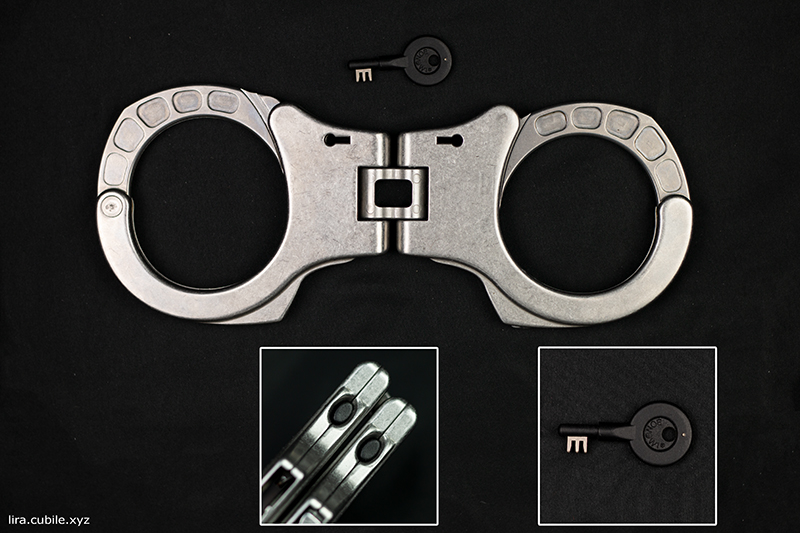
The hinged Trilock version. Bonowi also only sells to authorities, because of the special key form.
The key can be inserted from both sides of the cuff.
The doublelock is also a finger push.
The cuff includes the German TRI (in english: technical guideline).






























